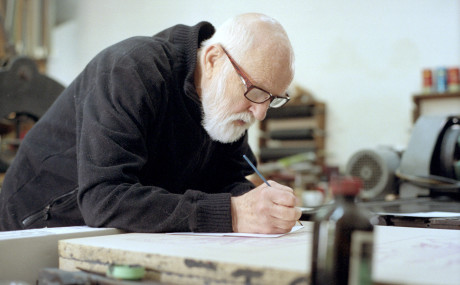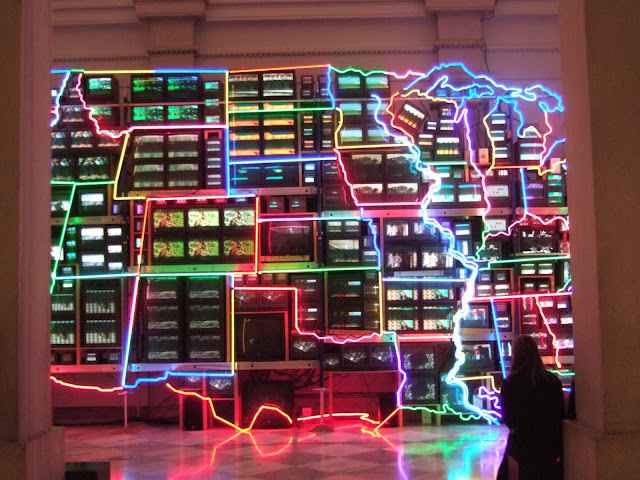Jan Švankmajer and his films, Down to the Cellar & Food
 |
| Jan Švankmajer. Taken from Jan Švankmajer's Indiegogo profile. |
The filmmaker whom his film has been the spotlight throughout multiple media for his use of surrealism in his high quality films.
Born on 4 September 1934 in Prague, Czech Republic. His journey started with one Christmas gift he received as a kid - a puppet theatre. This is the gift that ignited his artistic interest.
He continued his studies at College of Applied Arts in Prague and the Department of Puppetry at the Prague Academy of Performing Arts soon after that.Most of his career life after graduation was working in theatres, not limited to Semafor Theatre, Theatre of Masks and Laterna Magika multimedia theatre. With the experience he gotten, he soon released his first film The Last Trick in 1964.
He then shifted his focus to direct and produce surrealism films after the influence of Vratislav Effenberger. His first surrealism film, The Garden, was released in 1968.
He was married to Eva Švankmajer, a well known surrealist painter, ceramicist and writer. Both of them worked together on several movies including Alice, Faust and Otesánek. They had two children, Veronika and Václav. Unfortunately, Eva Švankmajer passed away on October 2005.
With the many films released by Jan Švankmajer, he has gotten a lot of attention and received many praises on his works from all over the world. Some of his proudest works include Down to the Cellar and Food.
Spoiler alert below! It is best experience a movie blindly (at least that is how I feel), so if you also feel like that, better enjoy both Down in the Cellar and Food first before continue reading below.
Down to the cellar (Do pivnice)
Down to the cellar is pretty different from all his other famous works like Food or Dimensions of Dialogue. The film mostly consist of real life acting, instead of Jan Švankmajer's claymation trademark.
This surrealism film starring a young child where she lives down in a cellar with supernatural phenomena surrounding her.
Since this is the first Jan Švankmajer's film I watched, I am pretty fascinated on how surrealism films look liked. Without any idea on the story behind this film, I bet the inspiration for this film would be mildly interesting. I also loved the pacing of the film, it didn't made me felt the film is "too slow".
The angle captured throughout the film mostly is close up to the subject of the scene, making the film looked like a horror movie. Despite that, it didn't felt like a horror film at all, might be because of the pacing and the soundtracks aren't designed to be horrifying in mind. I bet this short film was never meant to be a full fledged horror film, but rather for Jan Švankmajer to express his idea on surrealism.
Food (Jídlo)
The next film I watched after my first surrealism film and my first Jan Švankmajer's film is Food. This film presented Jan Švankmajer's favorite subject and medium in films - food. Just like his other works like Dimensions of Dialogue, he used food as the main medium along with other filming techniques like stop motion and claymation. The film consists of 3 parts, breakfast, lunch and dinner.After watching the whole film, I felt that this film reflects on how the society works during these 3 phases of time, but presented with surrealism.
During the breakfast part, one person comes in and operates another human being to get their breakfast. After enjoying their meal, that person would be fall into coma and the person being operated originally would leave the room and allow another person to enter the room. The cycle repeats with each person from the long queue outside the room.
In reality, almost every adult in this society, especially the white collars, is repeating their everyday morning routine. Just like in the film, everyone that comes in to the room did the exact same actions to obtain their food. A lot of people should be able to relate to this part of the film.
For lunch, two diners were sitting at the same table but aren't able to get the waiter's attention at all. One of the diner who wears and acts politely started to eat the flower from the vase on the table. The other diner who wears and acts less politely followed his actions and grab a flower to consume. The diner who ate the flower continued on to consume everything including his own clothing, the plate, the chair and the table. The other diner followed his actions every time he ate something.
After a while, both of them are naked, and without a table nor chairs, they are only left with dining utensil. The first diner ate his utensil, and the second diner followed. To the second diner's surprise, the first diner did not consume the utensil but rather he stored it in his mouth. The scene proceeded to the first diner approaching to eat the intimidated second diner.
All of these also felt like it is somehow connected to the everyday life of the human society, especially white collars who work in cities with highly concentrated population. Anyone who is in a packed city would know that looking for lunch is a difficult task. Almost every restaurant will be filled with people and the waiters can never get a break.
Dinner has a shorter run time compared to the other two parts of the film. It basically showed how 4 different person enjoyed their dinner, which is actually their own body parts.
This actually reflects on what the society might do every night. For example, the first person that starred during this part looked like a gourmet who took his time to prepare his own meal with his hands. Some of us would also do that during dinner time, since it is after working hours and everybody loves a hearty and fully packed meal.
Another example would be the second person, an athlete, eating his own foot. Comparing this to real life, a lot people plays sports during the night.
So from what I had watched, Food is a film meant to reflect the daily life of the members of the society.
Jan Švankmajer's awards and current state
Aside from the two short films above, Jan Švankmajer also released a full movie length long Alice in 1987. It is based on the story Alice in Wonderland, but with a surrealistic twist. It won the Annecy International Animated Film Festival's Feature Film Category in 1987. It was also nominated as the "Best Film" for the International Fantasy Film Award during Fantasporto in 1989.Currently, Jan Švankmajer is now working on his final project - Insects, which was set to release on Spring 2018! Check the project out in the link below!
Here's some links for you to visit:
Jan Švankmajer's YouTube Channel
The last film by Jan Švankmajer: Insects | Indiegogo
I would actually recommend you watching all the movie he produced. All of his work gives a new perspective on how you see the world.


Comments
Post a Comment